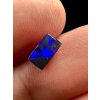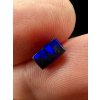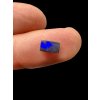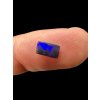Australian opal – Cabochon – Lightning Ridge, Australia
Locality: Lightning Ridge, Australia
Weight: 0,1g = 0,5ct
Dimensions: 0,7 x 0,41 x 0,21 cm
| Category: | Lightning Ridge |
|---|
Australia is renowned worldwide as the most important source of high-quality opals. The quality of Australian opals is primarily due to their strong and pure play of color. Thanks to specific formation conditions, they often exhibit vivid, contrasting hues. This diversity is reflected in the many types of opals Australia offers—from black and boulder opals to crystal, white, and matrix opals. Australian opals are notably more durable and stable compared to many opals from other localities. Their naturally lower water content increases their ability to withstand temperature fluctuations and changes in humidity, which means they do not crack or dry out as easily, making them ideal for everyday wear in jewelry.
Formation
Australian opals typically form in sedimentary rocks such as sandstones and clays, which are found in extensive basins (e.g., the Great Artesian Basin—a vast underground water system covering much of Australia’s interior). Water rich in silica gradually seeps into fine cracks or pores within the rock. Once this water evaporates or drains away, thin layers of silica remain in the cavities, which can eventually transform into opal.
Microscopic spheres of silicon dioxide (silica) play a key role: they arrange themselves into a regular, three-dimensional “crystal-like” lattice. This arrangement creates the characteristic “play-of-color,” the iridescent spectacle visible in opal when light hits it. The color and intensity of this effect depend on the size and arrangement of these spheres.
Deposits
Lightning Ridge is a legendary opal field located in the Australian state of New South Wales, about 770 kilometers northwest of Sydney. This area is especially famous for so-called black opals, which rank among the rarest and most valuable varieties of opal anywhere.
History
Mining here dates back to the late 19th century, but a real boom began in the early 20th century when explorers discovered layers containing opals with striking color effects. The name “Lightning Ridge” is linked to a legend in which a shepherd and his flock supposedly perished on a hill during a storm, struck by lightning. Whether fact or folklore, the story gave this place a memorable and evocative name.
Types of Australian Opals
-
Black Opal (Black Opal)
The rarest and most valuable type of opal, famous mainly for deposits around Lightning Ridge (New South Wales). It has a dark base color (black, gray, or dark blue), which enhances the play of color. Black opals often display the most intense range of colors, including red, green, blue, and purple. -
Boulder Opal
Mined primarily in Queensland (northeastern Australia). It forms when opal fills thin seams in iron-rich sandstone or various other types of host rock (“boulder”). This variety usually retains part of the original rock, creating a contrasting base. Boulder opals can feature a darker body tone and, like black opals, exhibit vivid color play. -
Crystal Opal
Characterized by a translucent or transparent base. Sometimes it may show little color in its raw state, yet when cut, the prismatic flashes become clear through a crystal-clear or milky-translucent background. Crystal opals occur throughout Australia, with larger amounts from localities like Coober Pedy. -
White (Light) Opal
This variety has a white to milky-white base color. It can exhibit colors as vibrant as those of black opals, but they typically appear less intense because the light background visually mutes the contrast. White opals are especially widespread in Coober Pedy (South Australia) and are more affordable than black or boulder opals. -
Matrix Opal
This is a special variety in which the opal is found within porous rock (such as sandstone or ironstone). After treatment (impregnation), the colors can become much more intense, as the darker substrate enhances the play-of-color. Andamooka is particularly known for these matrix opals, referred to as Andamooka Matrix, which can, once treated, resemble rare black opals from other areas.
Value
Prices for black opals from Lightning Ridge can climb to astronomical levels—depending on size, saturation, range of colors, the arrangement of patterns, and the stone’s clarity. The rarest specimens, those that feature dominant red or multiple bright hues, rank among the world’s most expensive gemstones.












